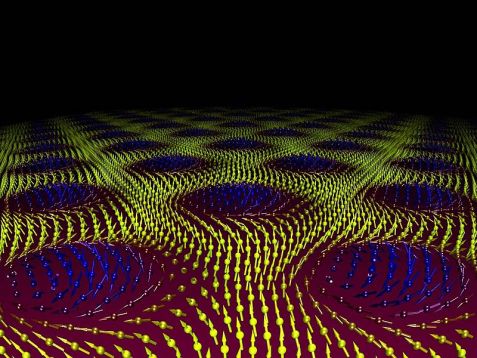MLZ is a cooperation between:
 > Technische Universität München
> Technische Universität München > Helmholtz-Zentrum Hereon
> Helmholtz-Zentrum Hereon
 > Forschungszentrum Jülich
> Forschungszentrum Jülich
MLZ is a member of:
 > LENS
> LENS > ERF-AISBL
> ERF-AISBL
MLZ on social media:

MLZ (eng)
Lichtenbergstr.1
85748 Garching
23.10.2011
ERC-Advanced Grant for research on magnetic vortices
Prof. Dr. Christian Pfleiderer at the chair of experimental physics E 21 of the TUM physics department receives a European grant for the research on stable magnetic vortices using neutrons.

The magnetic vortices were discovered using neutrons at the FRM II instrument MIRA in 2009. (Graphics: Sebastian Mühlbauer, TUM)
The 5-year project “Topological Spin Solitons for Information Technology“ is funded by 2.2 million Euros in an Advanced Grant of the European Research Council (ERC). The physicist wants to examine on the one hand, which material and structural classes display these novel magnetic vortices. Christian Pfleiderer will use neutron scattering instruments at the FRM II neutron source for this objective. On the other hand, the physical properties and the potential application, for example in information technology, shall be identified.

Prof. Dr. Christian Pfleiderer receives the ERC-Grant for further research on the magnetic vortices. (Photo: Eckert / Heddergott, TUM)
Christian Pfleiderer and his team had discovered the novel form of magnetic order consisting of magnetic vortices in 2009 using neutrons at the FRM II. While this work triggered high interest not only in the scientific world, the second discovery of Pfleiderers group followed: Again using neutron scattering, they showed that the magnetic vortices could be moved by a very low electric current. Since then the magnetic vortices are promising candidates for applications, which could revolutionize the information technology.
MLZ is a cooperation between:
 > Technische Universität München
> Technische Universität München > Helmholtz-Zentrum Hereon
> Helmholtz-Zentrum Hereon
 > Forschungszentrum Jülich
> Forschungszentrum Jülich
MLZ is a member of:
 > LENS
> LENS > ERF-AISBL
> ERF-AISBL
MLZ on social media:


